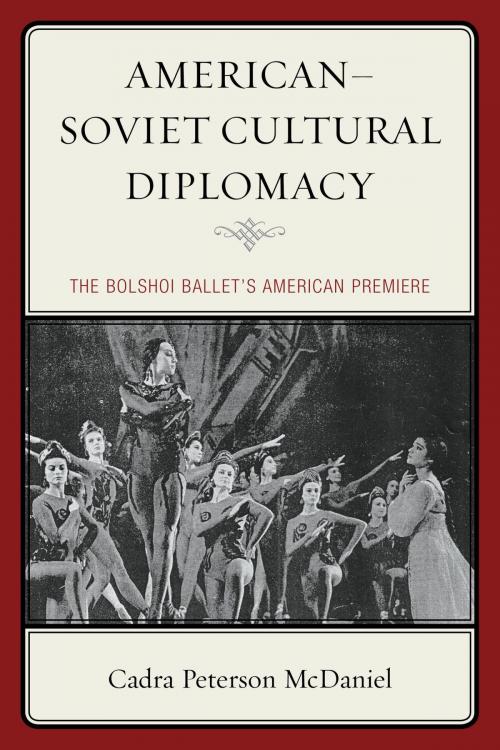American–Soviet Cultural Diplomacy
The Bolshoi Ballet's American Premiere
Nonfiction, Entertainment, Dance, Classical, History, Asian, Russia, Americas, United States, 20th Century| Author: | Cadra Peterson McDaniel | ISBN: | 9780739199312 |
| Publisher: | Lexington Books | Publication: | November 18, 2014 |
| Imprint: | Lexington Books | Language: | English |
| Author: | Cadra Peterson McDaniel |
| ISBN: | 9780739199312 |
| Publisher: | Lexington Books |
| Publication: | November 18, 2014 |
| Imprint: | Lexington Books |
| Language: | English |
American–Soviet Cultural Diplomacy: The Bolshoi Ballet’s American Premiere is the first full-length examination of a Soviet cultural diplomatic effort. Following the signing of an American-Soviet cultural exchange agreement in the late 1950s, Soviet officials resolved to utilize the Bolshoi Ballet’s planned 1959 American tour to awe audiences with Soviet choreographers’ great accomplishments and Soviet performers’ superb abilities. Relying on extensive research, Cadra Peterson McDaniel examines whether the objectives behind Soviet cultural exchange and the specific aims of the Bolshoi Ballet’s 1959 American tour provided evidence of a thaw in American-Soviet relations. Interwoven throughout this study is an examination of the Soviets’ competing efforts to create ballets encapsulating Communist ideas while simultaneously reinterpreting pre-revolutionary ballets so that these works were ideologically acceptable.
McDaniel investigates the rationale behind the creation of the Bolshoi’s repertoire and the Soviet leadership’s objectives and interpretation of the tour’s success as well as American response to the tour. The repertoire included the four ballets, Romeo and Juliet, Swan Lake, Giselle, and The Stone Flower, and two Highlights Programs, which included excerpts from various pre- and post-revolutionary ballets, operas, and dance suites. How the Americans and the Soviets understood the Bolshoi’s success provides insight into how each side conceptualized the role of the arts in society and in political transformation.
American–Soviet Cultural Diplomacy: The Bolshoi Ballet’s American Premiere demonstrates the ballet’s role in Soviet foreign policy, a shift to "artful warfare," and thus emphasizes the significance of studying cultural exchange as a key aspect of Soviet foreign policy and analyzes the continued importance of the arts in twenty-first century Russian politics.
American–Soviet Cultural Diplomacy: The Bolshoi Ballet’s American Premiere is the first full-length examination of a Soviet cultural diplomatic effort. Following the signing of an American-Soviet cultural exchange agreement in the late 1950s, Soviet officials resolved to utilize the Bolshoi Ballet’s planned 1959 American tour to awe audiences with Soviet choreographers’ great accomplishments and Soviet performers’ superb abilities. Relying on extensive research, Cadra Peterson McDaniel examines whether the objectives behind Soviet cultural exchange and the specific aims of the Bolshoi Ballet’s 1959 American tour provided evidence of a thaw in American-Soviet relations. Interwoven throughout this study is an examination of the Soviets’ competing efforts to create ballets encapsulating Communist ideas while simultaneously reinterpreting pre-revolutionary ballets so that these works were ideologically acceptable.
McDaniel investigates the rationale behind the creation of the Bolshoi’s repertoire and the Soviet leadership’s objectives and interpretation of the tour’s success as well as American response to the tour. The repertoire included the four ballets, Romeo and Juliet, Swan Lake, Giselle, and The Stone Flower, and two Highlights Programs, which included excerpts from various pre- and post-revolutionary ballets, operas, and dance suites. How the Americans and the Soviets understood the Bolshoi’s success provides insight into how each side conceptualized the role of the arts in society and in political transformation.
American–Soviet Cultural Diplomacy: The Bolshoi Ballet’s American Premiere demonstrates the ballet’s role in Soviet foreign policy, a shift to "artful warfare," and thus emphasizes the significance of studying cultural exchange as a key aspect of Soviet foreign policy and analyzes the continued importance of the arts in twenty-first century Russian politics.















